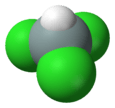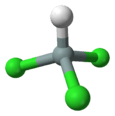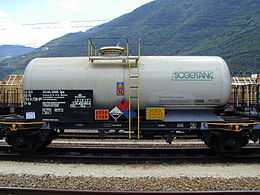Trichlorosilane
| Trichlorosilane | |
|---|---|
 | |
 |
 |
| IUPAC name trichlorosilane | |
| Other names silyl trichloride, silicochloroform | |
| Identifiers | |
| CAS number | 10025-78-2 |
| PubChem | 24811 |
| ChemSpider | 23196 |
| EC number | 233-042-5 |
| UN number | 1295 |
| RTECS number | VV5950000 |
| Jmol-3D images | {{#if:Cl[SiH](Cl)Cl|Image 1 |
| |
| |
| Properties | |
| Molecular formula | HCl3Si |
| Molar mass | 135.45 g/mol |
| Appearance | colourless liquid |
| Density | 1.342 g/cm3 |
| Melting point | −126.6 °C; −195.9 °F; 146.6 K |
| Boiling point | 31.8 °C; 89.2 °F; 304.9 K |
| Solubility in water | hydrolysis |
| Hazards | |
| MSDS | ICSC 0591 |
| EU Index | 014-001-00-9 |
| EU classification | Highly flammable (F+) Harmful (Xn) Corrosive (C) |
| R-phrases | R12, R14, R17, R20/22, R29, R35 |
| S-phrases | (S2), S7/9, S16, S26, S36/37/39, S43, S45 |
| NFPA 704 |
 4
3
2
|
| Flash point | −27 °C; −17 °F; 246 K |
| Autoignition temperature | 185 °C; 365 °F; 458 K |
| Explosive limits | 1.2–90.5% |
| Related compounds | |
| Related chlorosilanes | Chlorosilane Dichlorosilane Dichloromethylsilane Chlorodimethylsilane Silicon tetrachloride |
| Related compounds | Trifluorosilane Tribromosilane Chloroform |
| Except where noted otherwise, data are given for materials in their standard state (at 25 °C (77 °F), 100 kPa) | |
| Infobox references | |
Trichlorosilane is an inorganic compound with the formula HSiCl3. It is a colourless, volatile liquid. Purified trichlorosilane is the principal precursor to ultrapure silicon in the semiconductor industry. In water, it rapidly decomposes to produce a silicone polymer while giving off hydrochloric acid. Because of its reactivity and wide availability, it is frequently used in the synthesis of silicon-containing organic compounds.[1]
Production
Trichlorosilane is produced by treating powdered ferrosilicon with blowing hydrogen chloride at 300 °C. Hydrogen is also produced, as described in the chemical equation:
- Si + 3 HCl → HSiCl3 + H2
Yields of 80-90% can be achieved. The major byproducts are silicon tetrachloride (chemical formula SiCl4), hexachlorodisilane (Si2Cl6), and dichlorosilane (H2SiCl2), from which trichlorosilane can be separated by distillation.
- Tank car of trichlorosilane (the blue diamond means "Dangerous when wet").
It is also produced from silicon tetrachloride:[2]
- Si + 3 SiCl4 + 2 H2 → 4 HSiCl3
Applications
Trichlorosilane is the basic ingredient used in the production of purified polysilicons.
- HSiCl3 → Si + HCl + Cl2
Via hydrosilylation, trichlorosilane is a precursor to other useful organosilicon compounds:
- RCH=CH2 + HSiCl3 → RCH2CH2SiCl3
Some useful products of this or similar reactions include octadecyltrichlorosilane (OTS), perfluoroctyltrichlorosilane (PFOTCS), and perfluordecyltrichlorosilane (FDTS). These reagents used in surface science and nanotechnology to form Self-assembled monolayers. Such layers containing fluorine decrease surface energy and reduce sticking. This effect is usually exploited as coating for MEMS and microfabricated stamps for a nanoimprint lithography (NIL) and an injection molding tools.[3]
References
- ↑ Lianhong Xu, Ravi Kurukulasuriya, "Trichlorosilane" Encyclopedia of Reagents for Organic Synthesis, 2006. doi:10.1002/047084289X.rt213.pub2
- ↑ Simmler, W. (2005), "Silicon Compounds, Inorganic", Ullmann's Encyclopedia of Industrial Chemistry, Weinheim: Wiley-VCH, doi:10.1002/14356007.a24_001
- ↑ Cech J, Taboryski R (2012). "Stability of FDTS monolayer coating on aluminum injection molding tools". Applied Surface Science 259: 538–541. doi:10.1016/j.apsusc.2012.07.078.
